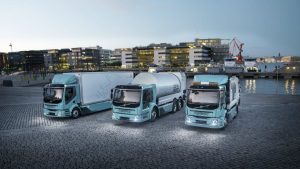EU Heavy Vehicle Emissions Deadline: New Targets and Implications

The European Union’s new heavy vehicle emissions deadline sets ambitious targets for trucks and buses to reduce their carbon-dioxide emissions.
The European Union’s new heavy vehicle emissions deadline sets ambitious targets for trucks and buses to reduce their carbon-dioxide emissions. These updated pollution targets are part of the EU’s larger plan to achieve greener transportation and combat climate change. While the goals are considered a step in the right direction, they also present significant challenges for the industry and policymakers.
The Emissions Reduction Targets for Heavy Vehicles
Under the new EU heavy vehicle emissions deadline, trucks and buses will be required to cut their emissions by 45 percent by 2030, 65 percent by 2035, and 90 percent by 2040. Although these targets are more lenient than the EU-wide ban on internal combustion engines for new cars starting in 2035, they still represent a significant change for the heavy vehicle industry.
Expanding the Scope of Emission Rules
Previously, the EU’s emission rules only covered heavy trucks. The commission now proposes to expand the scope to include small and large trucks, city buses, long-distance buses, and trailers. This expansion will help to further reduce carbon-dioxide emissions across the entire heavy vehicle sector.
Industry Concerns and Challenges

European truck manufacturers have expressed concern about the ambitious targets set by the EU heavy vehicle emissions deadline.
European truck manufacturers have expressed concern about the ambitious targets set by the EU heavy vehicle emissions deadline. They argue that achieving a 45 percent reduction by 2030 will require significant efforts from policymakers and other players in the transport and logistics value chain.
Enjoying our insights?
Subscribe to our newsletter to keep up with the latest industry trends and developments.
Stay InformedInfrastructure Needs for Zero-Emission Trucks
To achieve the emissions reduction targets, the European trade association ACEA estimates that more than 400,000 zero-emission trucks will need to be on the road by 2030, with at least 100,000 new zero-emissions trucks registered annually. This will necessitate over 50,000 publicly-accessible chargers suitable for trucks within just seven years, including 35,000 high-performance chargers, as well as 700 hydrogen refilling stations.
Meeting these infrastructure requirements will be a considerable challenge. Currently, charging stations suited for trucks are almost completely missing, making the task of building this network a monumental effort. Policymakers, industry stakeholders, and infrastructure providers will need to collaborate to ensure that the necessary charging and refueling infrastructure is in place to support the large-scale deployment of zero-emission heavy vehicles.
The Impact of the EU Heavy Vehicle Emissions Deadline on the Global Industry
If the proposed targets are accepted, the EU would set a world-leading standard for heavy-duty vehicle emissions. This would have a significant impact on the global industry, with major manufacturers like Scania and Daimler Truck pledging to go beyond the 90 percent target and only sell zero-emission vehicles by 2040.
A Complex Roadmap for the Industry
The ambitious targets set by the EU heavy vehicle emissions deadline create a complex roadmap for the industry, requiring rapid technological advancements, significant infrastructure development, and increased collaboration among various stakeholders. Policymakers, manufacturers, and other players in the transport and logistics value chain must work together to overcome these challenges and ensure a cleaner, greener future for heavy vehicle transportation.

To meet the targets set by the EU heavy vehicle emissions deadline, the industry will need to accelerate the development and adoption of advanced technologies such as battery-electric and hydrogen fuel cell vehicles.
Encouraging Technological Innovations
To meet the targets set by the EU heavy vehicle emissions deadline, the industry will need to accelerate the development and adoption of advanced technologies such as battery-electric and hydrogen fuel cell vehicles. Governments and industry stakeholders should collaborate to support research and development, as well as create incentives for the rapid deployment of these technologies.
Potential Negative Impacts of the EU Heavy Vehicle Emissions Deadline
While the EU heavy vehicle emissions deadline has numerous positive implications for the environment and the transition to green transportation, there are potential negative impacts that must be considered and addressed. These may include economic challenges, job displacement, and concerns about the environmental impact of battery production.
Economic Challenges for the Industry
The ambitious emissions targets may place a significant financial burden on the heavy vehicle industry, particularly for smaller manufacturers and transport companies. The costs associated with developing, producing, and deploying zero-emission vehicles can be substantial, which may lead to increased prices for customers and potential difficulties for businesses trying to compete in the market. Policymakers must balance the need for emissions reduction with the economic realities faced by industry stakeholders
External Resources:
- International Council on Clean Transportation (ICCT)
- European Automobile Manufacturers Association (ACEA)
For more News on Emissions Regulations and their Impact on the Transportation Industry click here




















